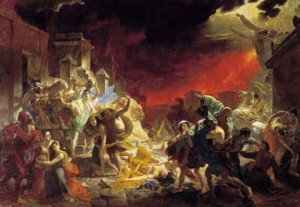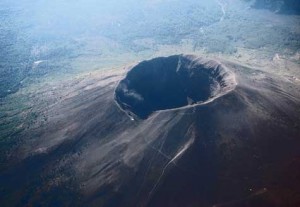Ever since 19th-century archaeologists started making plaster casts of the fallen inhabitants of Pompeii, it has been assumed they died from suffocation as a thick layer of ash fell on the town following a massive eruption of nearby Mt. Vesuvius in 79 A.D.
But a new report from a team of Italian scientists tells a very different tale about what happened to the residents of the Roman town, and it has important implications for the 3 million people who today live around the world’s most dangerous volcano.
A meticulous study of bones, household objects and other evidence — a little like a CSI investigation of a 1,900-year-old cold case — suggests that the victims died suddenly in an intense blast of fine ash and superheated gas called a pyroclastic surge, says Giuseppe Mastrolorenzo, a senior researcher at the Vesuvius Observatory in Naples.
“Impact and suffocation were not important,” he says. “The victims were killed by the high temperatures.”

The deadly surge passed through Pompeii, a little over 6 miles from Vesuvius, at a speed of around 40 mph, instantly raising temperatures to 500 degrees Fahrenheit and causing sudden death, Mastrolorenzo says. The victims were found in postures characteristic of cadaveric spasm, in which the muscles stiffen at the moment of death, according to the study.
Ominously, the lethal effects of a succession of six pyroclastic surges from the eruption extended more than 12 miles from Vesuvius. The findings were reported in “Lethal Thermal Impact at Periphery of Pyroclastic Surges: Evidences at Pompeii,” published online at the PLoS One website.
At the time of the eruption, Pompeii was a thriving seaside town of about 15,000-20,000 on the Gulf of Naples. Even then, the surrounding region of Campania, which had been blanketed by ash from eruptions going back thousands of years, was densely populated due to the mineral-rich volcanic soil.
At midday on Aug. 24, 79 A.D., earthquakes and belching ash from the volcano presaged the impending eruption. “At least 90 percent of the people were able to evacuate in the early phase of the eruption,” Mastrolorenzo says. But for unknown reasons, about 1,000 people remained behind (calling to mind those who decided to stay in New Orleans as Hurricane Katrina bore down).

The first three surges from the volcano did not reach Pompeii, although there was a heavy ash fall, sufficient to cause some building roofs to collapse, Mastrolorenzo says.
Although they did not know it, the remaining residents were already doomed. As the layer of ash grew thicker, it became harder to move about (“It’s like walking on snow,” Mastrolorenzo says). Even worse, visibility had declined to almost zero. “Probably they had no idea in which direction to escape because everything was in complete darkness,” Mastrolorenzo says.
After the deadly fourth surge passed through early the next morning, two final surges blanketed the town in meters of ash, burying it so deeply that later generations forgot it had ever existed.
Pompeiians had no concept of what a volcanic eruption was because none had happened in their living memory. “At the first moment, they probably confused the eruption with a storm or a fire on the mountain,” he says. “They could not imagine that a quiet mountain like Vesuvius could change so abruptly.”
Mastrolorenzo believes people living in the region today are not much different. The last eruption occurred in 1944, during World War II, meaning most residents are too young to remember it, he says.
Although a network of sensors continually monitors ground deformation, gas composition and gravity changes, scientists would not be able to predict exactly when the volcano might blow even if the pattern of activity began to pick up. And, as the new study shows, Vesuvius can kill with terrifying speed.
An evacuation plan exists on paper, but it has not been updated recently and makes unwarrantedly optimistic predictions, Mastrolorenzo says. Meanwhile, the last time authorities tried to simulate an evacuation (with just 1,800 residents), the buses that were supposed to be ferrying them to safety stalled in heavy traffic. (Again, reminiscent of New Orleans and Hurricane Katrina.)
“This is a major problem in mitigation,” he says – basically, residents and civil authorities don’t take the threat posed by Vesuvius seriously enough. “I’m studying why the common tendency is to be optimistic.”
Mastrolorenzo has also studied the powerful Avellino eruption of 3,780 years ago, which scattered the Bronze Age inhabitants of the Campanian plain and rendered the area around Vesuvius uninhabitable for hundreds of years. And he warns that the western suburbs of Naples are built atop Campei Flegrei, a collapsed volcanic caldera that in the past has seen “super eruptions” — large enough to cause global climate change.
Shockingly, he says, no contingency plans exist should Campei Flegrei become active once more. He blames the city’s citizens as much as public officials.
“There is no interest,” he says, “because they prefer to care about everyday activity.”





